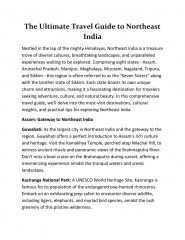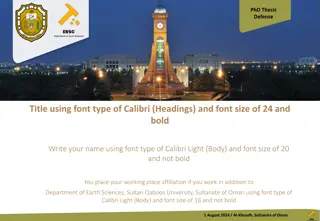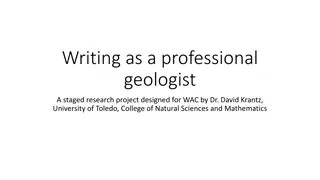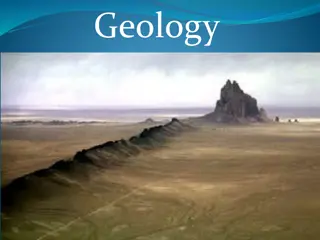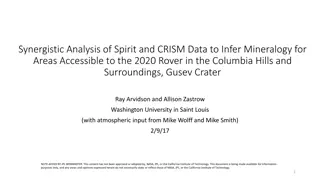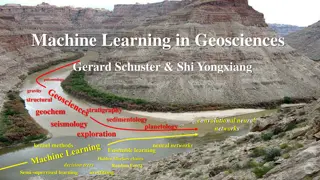Stratigraphy and Mineralogy of Northeast Syrtis Major
High-resolution work on Northeast Syrtis Major reveals diverse igneous lithologies and alteration products in a clear stratigraphy. The region displays great morphological heterogeneity at a decameter scale, yet it can be unified under five distinct geomorphic units. Geomorphic mapping and stratigraphic analysis provide valuable insights for the Mars 2020 project.
Download Presentation

Please find below an Image/Link to download the presentation.
The content on the website is provided AS IS for your information and personal use only. It may not be sold, licensed, or shared on other websites without obtaining consent from the author. Download presentation by click this link. If you encounter any issues during the download, it is possible that the publisher has removed the file from their server.
E N D
Presentation Transcript
Stratigraphy and Mineralogy of Northeast Syrtis Major Bramble MS, Mustard JF, Ehlmann BL, and Salvatore MS with Amador ES, Brown, AJ , Cannon KM, Des Marais, DJ, Goudge TA, Head JW, Milliken RE, Quinn DP, Skok JR, Viviano-Beck CE, and Wiseman SM 3rd landing site workshop for the 2020 Mars Rover mission NOTE ADDED BY JPL WEBMASTER: This content has not been approved or adopted by, NASA, JPL, or the California Institute of Technology. This document is being made available for information purposes only, and any views and opinions expressed herein do not necessarily state or reflect those of NASA, JPL, or the California Institute of
16 x 14 km NE Syrtis ellipse 13.3 x 7.8 km TRN ellipse Northeast Syrtis Major CTX mosaic
Initial high-resolution work identified diverse igneous lithologies and alteration products in a clear stratigraphy Regional Stratigraphy: Basement phyllosilicates, overlain by an olivine-rich unit, capped by Syrtis Major lavas Mangold et al., 2007 Ehlmann and Mustard, 2012 Northeast Syrtis Major records well-preserved changes in volcanic and aqueous alteration processes spanning the Noachian-Hesperian boundary
Geomorphic Mapping of Northeast Syrtis Major ELEVATION HiRISE CRISM Black rectangles = mapping extent Contacts drawn at 1:1,000 scale 17 geomorphic terrains mapped, but unified under 5 geomorphic units Bramble et al., in review
NE Syrtis displays great morphological heterogeneity at the decameter scale, but the region is unifiable under five distinct geomorphic units relatable to the regional and global geology. Simplified Stratigraphic Column Bramble et al., in review
Geomorphic map provided to the Mars 2020 project Capping Mafic Rock Olivine Carbonate Formation LCP-bearing Mounds Clay-rich basement Geomorphic units reclassified as Units of Interest
Early/Mid-Noachian Clay-rich basement a Fe/Mg-smectites Al-phyllosilicates b a b
Diverse lithologies Megabreccia Diverse megabreccia blocks throughout the basement, some >100m in diameter, preserve pre- Isidis materials and include both layered clays and primary igneous blocks.
OlivineCarbonate Variably Banded Formation Thermal IR analysis confirms CRISM compositions. Iterative unmixing of TES spectra confirms carbonate enrichment, with abundances of ~10 15% carbonate. Salvatore et al., in prep
CraterRetaining Capping Mafic Rock Capping rock bears no diagnostic CRISM absorptions. Iterative TES unmixing confirms relatively less altered condition and abundant primary phases. Salvatore et al., in prep Bramble et al., in review
Local stratigraphy regionally tied to mesa-like landforms composed of three major geomorphic units. Section has been studied in detail and is time-bracketed. A A A A
Proposed ROIs presented to Mars 2020 project prior to for LSW3 Capping Mafic Rock Olivine Carbonate Formation LCP-bearing Mounds Clay-rich basement 4 8 13 6 11 2 15 12 1 3 7 10 14 9 5
An Example Mars 2020 Sampling Campaign Example ROI1 Example Region of Interest 1
Olivine-rich linear features and high- standing bounding rims with basement Double-ridge landforms transitioning to raised ridge High-standing low-Ca pyroxene-bearing terrain Clay-rich crustal basement Olivine-carbonate- serpentine unit Capping unit enriched in high-Ca pyroxene and primary phases HiRISE Subframe
Olivine-rich linear features and high- standing bounding rims with basement Double-ridge landforms transitioning to raised ridge High-standing low-Ca pyroxene-bearing terrain Clay-rich crustal basement Example sample cache from ROI1: Mafic capping rocks High-Ca pyroxene enriched rocks Olivine-rich rock unit Olivine-carbonate- serpentine unit Carbonate-bearing rocks Raised Ridges Basement Fe/Mg phyllosilicates Capping unit enriched in high-Ca pyroxene and primary phases HiRISE Subframe
An Example Mars 2020 Sampling Campaign Example ROI1 Example ROI 2 Example Region of Interest 2
250 m HiRISE Subframe
Dissected high-standing low- Ca pyroxene-bearing terrain Two-tiered capping unit Light-toned features in basement Mafic capping unit Variable banding Fractured lower tier Olivine-carbonate- serpentine unit 250 m HiRISE Subframe
Dissected high-standing low- Ca pyroxene-bearing terrain Two-tiered capping unit Light-toned features in basement Example sample cache from ROI2: Mafic capping rocks Olivine-rich rock unit Serpentine-bearing rocks Al phyllosilicates Basement megabreccia Low-Ca pyroxene enriched basement Mafic capping unit Variable banding Fractured lower tier Olivine-carbonate- serpentine unit 250 m HiRISE Subframe
An Example Mars 2020 Sampling Campaign Example ROI1 Example ROI 2 Sample Cache Complete Continue in situ investigation
Summary: CRISM analysis confirms previous findings of diverse mineralogy at NE Syrtis Igneous minearlogies Olivine-rich unit Volcanic or impact melt hypotheses Low- and High-Ca pyroxene Volcanism, primitive crust, impacts Alteration / hydrous minearlogies Crustal phyllosilicates Hydrothermal, weathering, impact origins? Al-phyllosilicates Weathering horizons, leaching, initial heterogeneities? Carbonates Atmospheric sequestration / composition? Serpentine Serpentinization, carbonizing reactions? Sulfates Altered flows/ash, groundwater, evaporite sediments?
Summary: Stratigraphy / Geomorphology At NE Syrtis, varied lithologies including volcanics, impact products and melt, potential primitive crust, and more are present in a geological history spanning >250 Myr NE Syrtis adds to this sequence by exposing the diverse environmental history of this region through the presence of alteration minerals not seen in this fidelity or proximity elsewhere on Mars. NE Syrtis Nili Fossae Bramble et al., in review Adapted from Mangold et al., 2007
Northeast Syrtis Major: A Summary Land-on diverse units of astrobiological, geologic, petrologic, atmospheric, and climatologic importance 4 distinct episodes of aqueous activity in varying environmental conditions; 3 igneous lithologies; all in clear stratigraphy Many outstanding questions of Mars science have clues residing at NE Syrtis Returned samples would provide data on fundamental questions of ancient Mars, fostering decades of discovery Layering/banding of the olivine rich unit
Northeast Syrtis Major: A Summary Land-on diverse units of astrobiological, geologic, petrologic, atmospheric, and climatologic importance 4 distinct episodes of aqueous activity in varying environmental conditions; 3 igneous lithologies; all in clear stratigraphy Many outstanding questions of Mars science have clues residing at NE Syrtis Returned samples would provide data on fundamental questions of ancient Mars, fostering decades of discovery Layering/banding of the olivine rich unit
Northeast Syrtis Major: A Summary Land-on diverse units of astrobiological, geologic, petrologic, atmospheric, and climatologic importance 4 distinct episodes of aqueous activity in varying environmental conditions; 3 igneous lithologies; all in clear stratigraphy Many outstanding questions of Mars science have clues residing at NE Syrtis Returned samples would provide data on fundamental questions of ancient Mars, fostering decades of discovery Layering/banding of the olivine rich unit
Northeast Syrtis Major: A Summary Land-on diverse units of astrobiological, geologic, petrologic, atmospheric, and climatologic importance 4 distinct episodes of aqueous activity in varying environmental conditions; 3 igneous lithologies; all in clear stratigraphy Many outstanding questions of Mars science have clues residing at NE Syrtis Returned samples would provide data on fundamental questions of ancient Mars, fostering decades of discovery Layering/banding of the olivine rich unit
Northeast Syrtis Major: A Summary NE Syrtis embodies a spatially concentrated stratigraphic time capsule recording the majority of geological processes active in Nili Fossae during the Noachian and Hesperian
Northeast Syrtis Major mesas are spatially concentrated time capsules that record the majority of geological processes active on Mars during the Noachian and Hesperian and are special because of the large carbonate deposit. Characterize geologic history of astrobiologically relevant site/units 3 distinct, time-ordered formations (mafic cap, carbonate, basement); one with 3 subunits (megabreccia basement, massive basement, Al-phyllosilicate weathering horizon) are mappable from orbit for easy rover direction ~250 Myr early Noachian to Hesperian historical record is the earliest accessible and well-understood in the context of Mars history, bounded by the Isidis impact event and Syrtis Major volcanism, with still older megabreccia Assess habitability/past life in units with high biosignature preservation potential Regionally extensive carbonates represent either near-subsurface mineralization of host rock or travertine-like mineral springs precipitation either has high biosignature preservation potential The Noachian clay basement and breccia blocks within preserve rocks from the time Mars had a magnetic field and thicker atmosphere. Cross-crossing veins point to available water in a continuously habitable environment the NE Syrtis paleo-aquifer is a good place to search for mineralized life Cache scientifically compelling samples 4 aqueous environments (early clays, early carbonates, weathering horizons, go-to sulfate sediments) have distinct astrobio. potential, record of atm. evolution, volatile sequestration for traditional, clumped isotopes 4 age-date pins for Martian chronology (1) Isidis-formed melt within Noachian basement, (2) regional olivine-rich unit, (3) dark-toned mafic cap rock, (4) Syrtis lava front (go-to) 3 lithologies record Igneous evolutionary history from Pre-Noachian to Early Hesperian, with distinct low-Ca pyroxene, olivine enriched (komatiite-type hot lava or mantle xenolith), high-Ca pyroxene lavas


